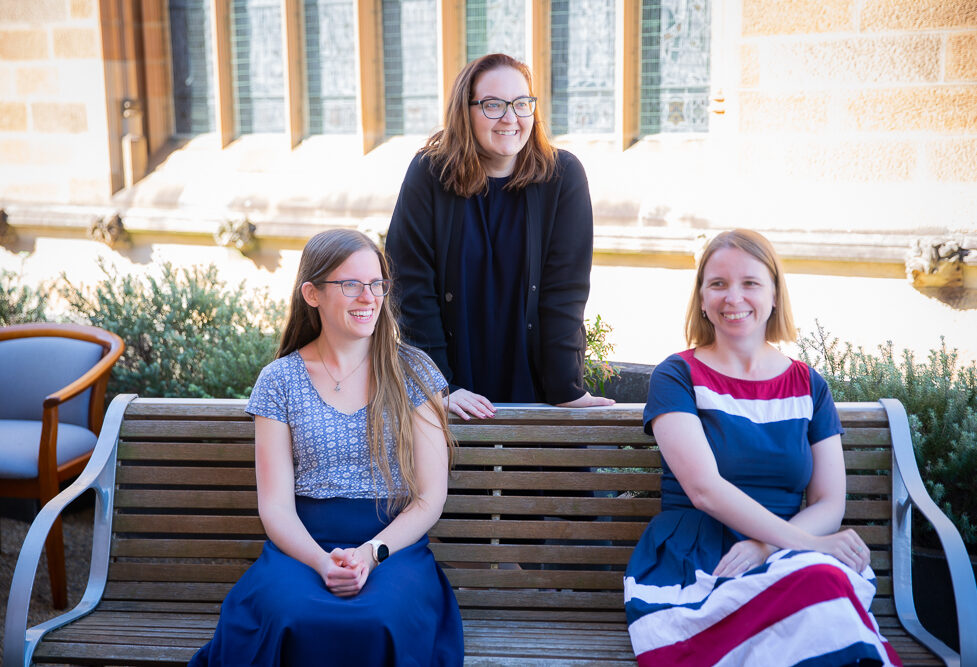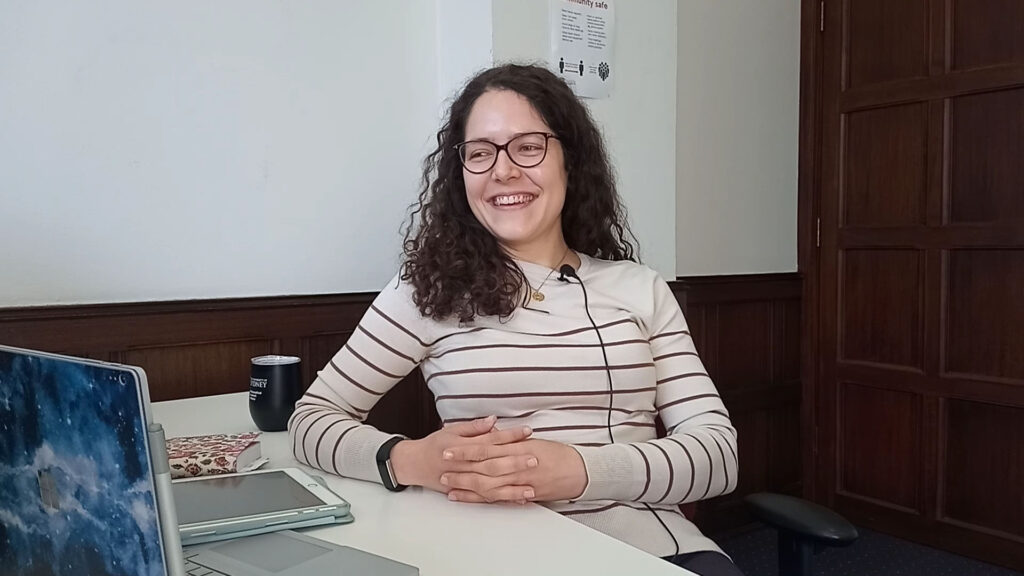Spotlight on topology and algebraic geometry: Iva Halacheva and Marcy Robertson
Kashiwara–Vergne equations in the language of wheeled props
Two SMRI visitors, Marcy Robertson and Iva Halacheva, have published a new paper that sets out a topological characterisation of the Kashiwara–Vergne groups. Their host, Zsuzsanna Dancso from the University of Sydney’s School of Mathematics and Statistics, is also a co-author on the paper.
Robertson, who is an Associate Professor at the University of Melbourne, visited SMRI in April 2021 as a domestic visitor, during which time she worked with her research collaborator Dancso and PhD student Tamara Hogan.
Halacheva is an Assistant Professor at Northeastern University in Boston and visited SMRI in mid-2023. She also spent time at the University of Melbourne (where she was previously a post-doc) and the Australian National University as part of her international visit.

From topology to quantum algebra (and vice versa)
The Kashiwara–Vergne (KV) conjecture was proposed in 1978 by Masaki Kashiwara and Michèle Vergne and concerns the combinatorial structures of Lie algebras. “The KV equations have a wide variety of implications across many mathematical fields including Lie theory, harmonic analysis, low dimensional topology, and even algebraic geometry,” explains Robertson.
In 2006, the KV conjecture was established for any Lie group and reformulated in terms of Lie algebra cohomology by Anton Alekseev and Eckhard Meinrenken. This result was followed by a series of seminal papers showing that solutions to the KV equations are closely related to quantised deformation theory, specifically Drinfeld associators. These are important objects in quantum algebra arising in many areas of mathematics. They were originally defined in the 1990s by renowned mathematician and Fields Medallist Vladimir Drinfeld, whose work connected algebraic geometry over finite fields with number theory.
Drinfeld associators are involved in the construction of homorphic expansions, which are known in knot theory as ‘universal finite type invariants’: powerful tools in low-dimensional topology. “Our interest in homomorphic expansions stems from their capacity to translate problems from topology to quantum algebra and vice versa,” explain the three authors in their latest paper, published in February 2023 in the Transactions of the American Mathematical Society.

The symmetries of Drinfeld associators are encapsulated by the Grothendieck-Teichmüller groups, which Drinfeld first defined in 1990. “It was a natural question for us to consider the symmetry groups of KV solutions, and their topological interpretation,” says Halacheva.
Dancso has been working on topological interpretations for the KV equations for several years. Working with SMRI visitor Professor Dror Bar-Natan, she developed a solution related to knots in four-dimensional space in 2017. Dancso and Bar-Natan specifically proved that solutions of the KV equations are in direct (one-to-one) correspondence with a class of structure-preserving functions on these four-dimensional knotted surfaces.
In Dancso’s new work with Halacheva and Robertson, the mathematicians aimed to use a new approach to KV equations to better understand the relationship with Drinfeld associators. “We wanted to build up the related computational tools from algebraic topology to better enable the application of KV solutions to a wide variety of mathematical problems,” says Robertson. The paper specifically considers welded foams, a class of knotted surfaces in four-dimensional space. Welded foams are a class of knotted tubes that can be presented algebraically as a circuit algebra, which provides a convenient language for tangles in low-dimensional topology.
The authors had two goals for this project, which follows on from a paper published in a paper published in 2021. The first was to better understand the connections between KV equations and welded foams. The second goal was to build a computational framework aimed at understanding the precise relationship to Drinfeld associators. Such associators capture the structural data of braided tensor categories, which provide another important source of invariant functions in low-dimensional topology.
Applying different tools to interpretations of KV solutions
The three mathematicians all come from different mathematical backgrounds. “Zsuzsanna is an expert in low-dimensional knot theory and quantum topology. Iva is an algebraist and our expert on Lie algebras,” says Robertson, whose background is in algebraic topology and homotopy theory. “My specialty is in building algebraic and categorical formalism in which problems like the KV equations can be simplified.”
“In this paper and its prequel, we set the topological interpretation of KV solutions into the language of (wheeled) props,” explains Robertson. A prop (“PROduct and Permutation category”) is a strict symmetric monoidal category generated by a single object. Wheeled props arise naturally in deformation theory, invariant theory and in aspects of theoretical physics.
“Important works by Bar-Natan, Fresse, Tamarkin, Willwacher and others have shown that similar techniques are useful in the study of Drinfeld associators,” says Robertson. This paper’s approach is particularly significant because it applies the language of props to the study of Drinfeld associators. “This allows one to access the vast arsenal of computational tools from algebraic topology [and apply them to the study of] Drinfeld associators,” says Robertson.
Robertson believes that the different mathematical backgrounds of her collaborators was both a challenge and one of the highlights of the project. “It can be hard to find a common language, but it is also the most fruitful way to do interesting mathematics,” she remarks. “Plus, Iva and Zsuzsi are just a lot of fun.”
“One of the most exciting aspects of this project is that it lies at the intersection of homotopy theory, low-dimensional topology, and representation theory,” comments Halacheva. “Working on it required a combination of ideas from these different fields, and the results we obtained in turn speak to several different research communities within mathematics.’’
Robertson says that her research visit to SMRI meant that she could make the most of a peaceful and productive environment. “It is really nice to have such a place in Australia as cutting out distraction is 80 percent of the struggle in doing quality mathematics.”
Read the last two research profiles in this series: “Spotlight on network dynamics: Bob Rink” and “Spotlight on spectral flow: Matthias Lesch”.
- Interview with Jessica Fintzen - 2024 March 20
- “Geometry: the archetype of beauty” public lecture and photo gallery - 2024 March 15
- Pi Day 2024: public lecture & Sydney high school workshops - 2024 February 6

